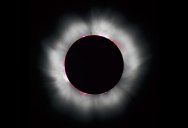Everything You Need to Know About the Most Anticipated Solar Eclipse in US History
by twistedsifter

On August 21st, for the first time in 99 years, a total solar eclipse will cut through the entire continental United States. This year’s solar eclipse could be the most viewed celestial event in history. [source]
Roughly 12 million people already live in its main path (on August 21, all they have to do is step outside and gaze up) and another 78 to 88 million more Americans live within 200 miles of the eclipse’s trajectory. [source]
Here’s everything you need to know about the 2017 total solar eclipse!
I Want to See a Total Solar Eclipse
– NASA has created an interactive map that lets you find the path of the total solar eclipse closest to you
– You can view and download high-resolution maps by state of the path of the total solar eclipse here (also by NASA)
– NASA has an entire microsite dedicated to the event with tons of information: https://eclipse2017.nasa.gov/
– Great American Eclipse also has a TON of information on the event and the best places to view it across the United States
– They also have highly detailed maps and times of the total solar eclipse’s path here

You can see a partial eclipse, where the moon covers only a part of the sun, anywhere in North America. To see a total eclipse, where the moon fully covers the sun for a short few minutes, you must be in the path of totality. The path of totality is a relatively thin ribbon, around 70 miles wide, that will cross the U.S. from West to East. The first point of contact will be at Lincoln Beach, Oregon at 9:05 a.m. PDT. Totality begins there at 10:16 a.m. PDT. Over the next hour and a half, it will cross through Oregon, Idaho, Wyoming, Montana, Nebraska, Iowa, Kansas, Missouri, Illinois, Kentucky, Tennessee, Georgia, and North and South Carolina. The total eclipse will end near Charleston, South Carolina at 2:48 p.m. EDT. From there the lunar shadow leaves the United States at 4:09 EDT. Its longest duration will be near Carbondale, Illinois, where the sun will be completely covered for two minutes and 40 seconds. [source]

What’s Going on Exactly?
On Monday, August 21, 2017, all of North America will be treated to an eclipse of the sun. Anyone within the path of totality can see one of nature’s most awe-inspiring sights – a total solar eclipse. This path, where the moon will completely cover the sun and the sun’s tenuous atmosphere – the corona – can be seen, will stretch from Lincoln Beach, Oregon to Charleston, South Carolina. [source]
This is a celestial event in which the moon passes between the sun and Earth and blocks all or part of the sun for up to about three hours, from beginning to end, as viewed from a given location. For this eclipse, the longest period when the moon completely blocks the sun from any given location along the path will be about two minutes and 40 seconds. [source]
A total solar eclipse presents a rare opportunity to observe the corona and chromosphere, the two outer most layers of the sun’s atmosphere. Under normal circumstances, the bright yellow surface of the sun, called the photosphere, is the only feature we can observe. But during an eclipse, the moon blocks out that intense light. [source]
The corona is the outer atmosphere of the sun. It is made of tenuous gases and is normally hiding in plain sight, overwhelmed by the bright light of the sun’s photosphere. When the moon blocks the sun’s face during a total solar eclipse, the corona is revealed as a pearly-white halo around the sun. [source]
During a total solar eclipse, the normal rhythms of Earth are disrupted. The sudden blocking of the sun makes the day appear to be night in more ways than just the loss of light. The temperature drops and plants and animals react as if it is dusk – birds can be seen flying home to settle in for sleep in the middle of the day. [source]
Okay Just Tell Me When and Where To Go



How Do I View a Solar Eclipse Safely?

– Looking directly at the sun is unsafe except during the brief total phase of a solar eclipse (“totality”), when the moon entirely blocks the sun’s bright face, which will happen only within the narrow path of totality
– The only safe way to look directly at the uneclipsed or partially eclipsed sun is through special-purpose solar filters, such as “eclipse glasses” or hand-held solar viewers. Homemade filters or ordinary sunglasses, even very dark ones, are not safe for looking at the sun; they transmit thousands of times too much sunlight
– Refer to the American Astronomical Society (AAS) Reputable Vendors of Solar Filters & Viewers page for a list of manufacturers and authorized dealers of eclipse glasses and handheld solar viewers verified to be compliant with the ISO 12312-2 international safety standard for such products
– Always inspect your solar filter before use; if scratched or damaged, discard it.
– Always supervise children using solar filters
– Stand still and cover your eyes with your eclipse glasses or solar viewer before looking up at the bright sun. After looking at the sun, turn away and remove your filter — do not remove it while looking at the sun
– Do not look at the uneclipsed or partially eclipsed sun through an unfiltered camera, telescope, binoculars, or other optical device
– Similarly, do not look at the sun through a camera, a telescope, binoculars, or any other optical device while using your eclipse glasses or hand-held solar viewer — the concentrated solar rays will damage the filter and enter your eye(s), causing serious injury
– If you are within the path of totality, remove your solar filter only when the moon completely covers the sun’s bright face and it suddenly gets quite dark. Experience totality, then, as soon as the bright sun begins to reappear, replace your solar viewer to look at the remaining partial phases
– Outside the path of totality, you must always use a safe solar filter to view the sun directly
– If you normally wear eyeglasses, keep them on. Put your eclipse glasses on over them, or hold your handheld viewer in front of them
– Visit NASA for complete safety and eclipse viewing information

I’m busy that day, when can I see the next Total Solar Eclipse in the US?

I still don’t see what the big deal is
In a recent conversation with VOX, Ernie Wright, who creates data visualizations and eclipse maps for NASA summed it up perfectly:
You suddenly feel as though you can see the clockwork of the solar system. Where you think you lived doesn’t look like the same place anymore. We kind of know — in the back of our minds — that we live in a giant ball and it revolves around a hot ball of gas, and we’re floating in space. But you don’t really believe it until you see something like a total solar eclipse, where everything is all lined up and you go whoaaa. Other planets pop out. You got instant nighttime. And you can see Mercury and Venus usually. And sometimes Mars and Jupiter. … It looks like the pictures from the textbook. It’s not entirely a science thing anymore. … It’s mostly a thing where you have a better appreciation of where you are in the solar system. [source]

Trending on TwistedSifter

Parents Emotionally Manipulated Grandparent Into Babysitting For 5 Days, So They Took The Kids To Disney Without The Parents







